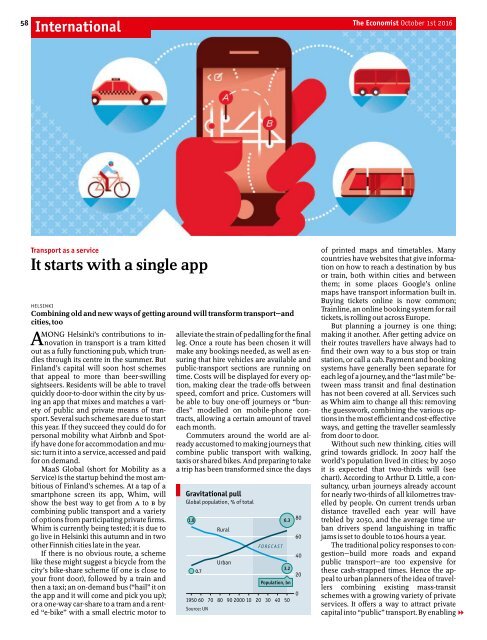Create successful ePaper yourself
Turn your PDF publications into a flip-book with our unique Google optimized e-Paper software.
International<br />
58 <strong>The</strong> <strong>Economist</strong> October 1st 2016<br />
Transport as a service<br />
It starts with a single app<br />
HELSINKI<br />
Combining old and new ways ofgetting around will transform transport—and<br />
cities, too<br />
AMONG Helsinki’s contributions to innovation<br />
in transport is a tram kitted<br />
out as a fully functioning pub, which trundles<br />
through its centre in the summer. But<br />
Finland’s capital will soon host schemes<br />
that appeal to more than beer-swilling<br />
sightseers. Residents will be able to travel<br />
quickly door-to-door within the city by using<br />
an app that mixes and matches a variety<br />
of public and private means of transport.<br />
Several such schemes are due to start<br />
this year. If they succeed they could do for<br />
personal mobility what Airbnb and Spotify<br />
have done foraccommodation and music:<br />
turn it into a service, accessed and paid<br />
for on demand.<br />
MaaS Global (short for Mobility as a<br />
Service) is the startup behind the most ambitious<br />
of Finland’s schemes. At a tap of a<br />
smartphone screen its app, Whim, will<br />
show the best way to get from A to B by<br />
combining public transport and a variety<br />
ofoptions from participating private firms.<br />
Whim is currently being tested; it is due to<br />
go live in Helsinki this autumn and in two<br />
other Finnish cities late in the year.<br />
If there is no obvious route, a scheme<br />
like these might suggest a bicycle from the<br />
city’s bike-share scheme (if one is close to<br />
your front door), followed by a train and<br />
then a taxi; an on-demand bus (“hail” it on<br />
the app and it will come and pick you up);<br />
or a one-way car-share to a tram and a rented<br />
“e-bike” with a small electric motor to<br />
alleviate the strain ofpedallingfor the final<br />
leg. Once a route has been chosen it will<br />
make any bookings needed, as well as ensuring<br />
that hire vehicles are available and<br />
public-transport sections are running on<br />
time. Costs will be displayed for every option,<br />
making clear the trade-offs between<br />
speed, comfort and price. Customers will<br />
be able to buy one-off journeys or “bundles”<br />
modelled on mobile-phone contracts,<br />
allowing a certain amount of travel<br />
each month.<br />
Commuters around the world are already<br />
accustomed to making journeys that<br />
combine public transport with walking,<br />
taxis orshared bikes. And preparingto take<br />
a trip has been transformed since the days<br />
Gravitational pull<br />
Global population, % of total<br />
1.8<br />
0.7<br />
Source: UN<br />
Rural<br />
Urban<br />
FORECAST<br />
6.3<br />
3.2<br />
Population, bn<br />
1950 60 70 80 90 2000 10 20 30 40 50<br />
80<br />
60<br />
40<br />
20<br />
0<br />
of printed maps and timetables. Many<br />
countries have websites that give information<br />
on how to reach a destination by bus<br />
or train, both within cities and between<br />
them; in some places Google’s online<br />
maps have transport information built in.<br />
Buying tickets online is now common;<br />
Trainline, an online bookingsystem for rail<br />
tickets, is rolling out across Europe.<br />
But planning a journey is one thing;<br />
making it another. After getting advice on<br />
their routes travellers have always had to<br />
find their own way to a bus stop or train<br />
station, or call a cab. Payment and booking<br />
systems have generally been separate for<br />
each legofa journey, and the “last mile” between<br />
mass transit and final destination<br />
has not been covered at all. Services such<br />
as Whim aim to change all this: removing<br />
the guesswork, combining the various optionsin<br />
the mostefficientand cost-effective<br />
ways, and getting the traveller seamlessly<br />
from door to door.<br />
Without such new thinking, cities will<br />
grind towards gridlock. In 2007 half the<br />
world’s population lived in cities; by 2050<br />
it is expected that two-thirds will (see<br />
chart). According to Arthur D. Little, a consultancy,<br />
urban journeys already account<br />
for nearly two-thirds of all kilometres travelled<br />
by people. On current trends urban<br />
distance travelled each year will have<br />
trebled by 2050, and the average time urban<br />
drivers spend languishing in traffic<br />
jams is set to double to 106 hours a year.<br />
<strong>The</strong> traditional policy responses to congestion—build<br />
more roads and expand<br />
public transport—are too expensive for<br />
these cash-strapped times. Hence the appeal<br />
to urban planners ofthe idea of travellers<br />
combining existing mass-transit<br />
schemes with a growing variety of private<br />
services. It offers a way to attract private<br />
capital into “public” transport. By enabling1


